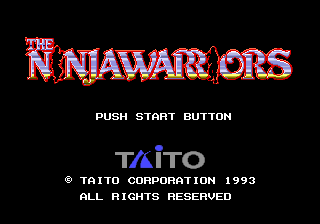Difference between revisions of "The Ninja Warriors"
From Sega Retro
Firbin4576 (talk | contribs) |
m (Text replace - "Sega Mega CD" to "Sega Mega-CD") |
||
| Line 5: | Line 5: | ||
| publisher=[[Taito]] | | publisher=[[Taito]] | ||
| developer=[[Taito]], {{MCD}} [[Aisystem Tokyo]] | | developer=[[Taito]], {{MCD}} [[Aisystem Tokyo]] | ||
| − | | system=[[Sega Mega CD]] | + | | system=[[Sega Mega-CD]] |
| romsize= | | romsize= | ||
| sounddriver= | | sounddriver= | ||
| Line 17: | Line 17: | ||
}} | }} | ||
}} | }} | ||
| − | {{sub-stub}}'''''The Ninja Warriors''''' (ニンジャウォーリアーズ) is a beat-'em-up originally developed by [[Taito]] for the arcades. It was brought to the [[Sega Mega CD]] in 1993 exclusively for Japan. To emulate the three-screen setup of the original arcade game (3 288x224 screens arranged in a horizontal line like with the ''Darius'' games), porters [[Aisystem Tokyo]] simply capped the screen resolution in software, resulting in the entire game running in a small window. | + | {{sub-stub}}'''''The Ninja Warriors''''' (ニンジャウォーリアーズ) is a beat-'em-up originally developed by [[Taito]] for the arcades. It was brought to the [[Sega Mega-CD]] in 1993 exclusively for Japan. To emulate the three-screen setup of the original arcade game (3 288x224 screens arranged in a horizontal line like with the ''Darius'' games), porters [[Aisystem Tokyo]] simply capped the screen resolution in software, resulting in the entire game running in a small window. |
==Physical Scans== | ==Physical Scans== | ||
Revision as of 21:34, 3 December 2013
| The Ninja Warriors | |||||
|---|---|---|---|---|---|
| System(s): Sega Mega-CD | |||||
| Publisher: Taito | |||||
| Developer: Taito, Aisystem Tokyo | |||||
| Genre: Action | |||||
| Number of players: 1-2 | |||||
|
This teeny-tiny article needs some work. You can help us by expanding it.
The Ninja Warriors (ニンジャウォーリアーズ) is a beat-'em-up originally developed by Taito for the arcades. It was brought to the Sega Mega-CD in 1993 exclusively for Japan. To emulate the three-screen setup of the original arcade game (3 288x224 screens arranged in a horizontal line like with the Darius games), porters Aisystem Tokyo simply capped the screen resolution in software, resulting in the entire game running in a small window.
Physical Scans
| Sega Retro Average | |||||||||||||||||||||||||||||||||||||||||||||||||||||||||||||||||||||||||||||||
|---|---|---|---|---|---|---|---|---|---|---|---|---|---|---|---|---|---|---|---|---|---|---|---|---|---|---|---|---|---|---|---|---|---|---|---|---|---|---|---|---|---|---|---|---|---|---|---|---|---|---|---|---|---|---|---|---|---|---|---|---|---|---|---|---|---|---|---|---|---|---|---|---|---|---|---|---|---|---|---|
|
| 53 | |
|---|---|
| Based on 15 reviews | |
- ↑ Beep! MegaDrive, "March 1993" (JP; 1993-02-08), page 24
- ↑ Consoles +, "Février 1993" (FR; 1993-0x-xx), page 70
- ↑ Computer & Video Games, "August 1993" (UK; 1993-07-15), page 90
- ↑ Electronic Gaming Monthly, "July 1993" (US; 1993-xx-xx), page 27
- ↑ Famitsu, "" (JP; 1993-03-05), page 1
- ↑ GameFan, "Volume 1, Issue 5: April 1993" (US; 1993-xx-xx), page 15
- ↑ Hippon Super, "March 1993" (JP; 1993-02-04), page 39
- ↑ Mega, "August 1993" (UK; 1993-07-15), page 48
- ↑ Mega Action, "September 1993" (UK; 1993-08-12), page 24
- ↑ Mega Play, "December 1993" (US; 1993-1x-xx), page 77
- ↑ MegaTech, "June 1993" (UK; 1993-05-20), page 70
- ↑ Mean Machines Sega, "May 1993" (UK; 1993-04-24), page 44
- ↑ Sega Force Mega, "August 1993" (UK; 1993-06-24), page 40
- ↑ Sega Saturn Magazine, "September 1995" (JP; 1995-08-08), page 85
- ↑ Video Games, "1/94" (DE; 1993-12-19), page 51


